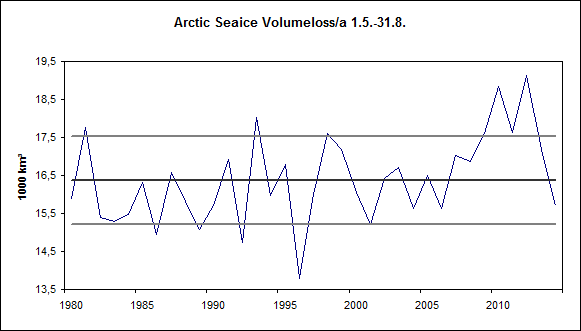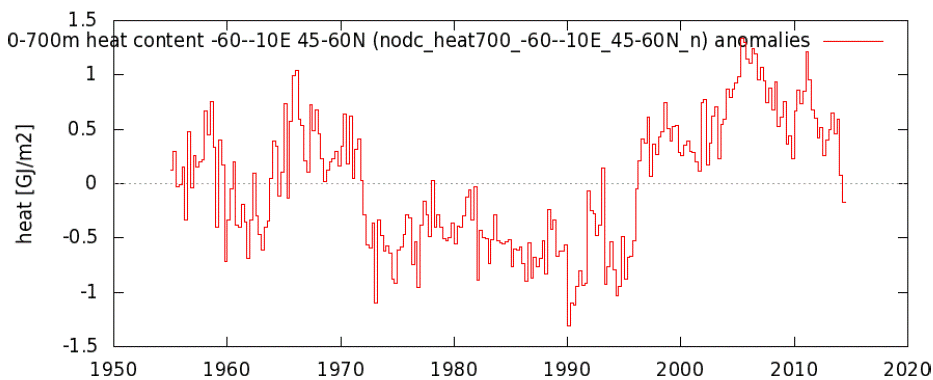What follows is the Arctic part of Prof. Fritz Vahrenholt’s and Frank Bosse’s recently posted article: The sun August 2014, the internal variability of the climate and the latest on Arctic ice. Time permitting, I will do the translation of the solar part a little later.
================================
The Latest News On Arctic Ice
By Prof. Fritz Vahrenholt and Frank Bosse
(Translated, edited by P Gosselin)
In our column from the previous month, we took a look at the ice volume in the Arctic. Since then summer has come to an end and the data for the May-August period are now available from PIOMAS.
If one computes the loss in ice volume (the melt) for each individual year from May 1st to August 31st of each year, we get a surprise:

Figure 4: Annual Arctic sea ice volume loss (thousands of cubic km) according to PIOMAS (blue) compared with the mean value 1980-2013 (black) and standard deviation (gray).
After the very high melt rates of the 2007-2012 period, the trend reversed in 2013 and especially in 2014 when the melt fell below the long-term average. What could be the reasons for this? Currently one can only speculate. One clue can be taken from a study by Mojib Latif from the year 2013:
It was suggested that the AMOC might be capable of influencing Arctic sea ice on this time scale through the inflow of Atlantic Water into the Arctic Ocean.”
We’ve reported on the Atlantic Meridional Overturning Circulation (AMOC) on several occasions, the last time here. Could it be that the AMOC acts as a decisive internal component of variability for Arctic ice melt? Let’s carry out a short plausibility check: The impact of the AMOC can be especially well depicted by the course of the heat content of the upper 700 meters of water in the area of the North Atlantic between 45°N – 60°N and 60°W – 10°W.
And what do we see?

Figure 5: Heat content south of the polar Atlantic until June 2014 (Diagram from Climate Explorer)
We see a real plummet over the last few months, which by the way was anticipated at the beginning of the year as we reported here.
The claims made by Prof. Mojib Latif et. al. have thus withstood this test. Is that the entire explanation? Probably not. In any case, the internal variability of our climate in many ways plays a far greater role than models and some climate scientists claim. Should that be the case, then the following must be assumed: The sensitivity of our climate with respect to greenhouse gases is not as high as some (97%??) have assumed so far.
In other words: The 21st century climate catastrophe is not taking place.





Another possibility, since the Russians are returning, could the underwater volcano’s have quieted down. It’s been at least two years since we have heard anything about them. But, then again, less warmer water melts less ice above it, along with the other factors. Sends cold further down then usual. Less energy from above slows the mixing of the warm and cold air, producing less rain/snow.
I watched the drift maps this summer. What I noticed was practically no ice being blown out the Fram Strait. The ice was kept tightly packed and mostly pushed up against the North American landmass. This would possibly reduce ice area and extent but would cause greater ice volume.
The drift map I check frequently (usually once a day) is here:
http://www7320.nrlssc.navy.mil/hycomARC/navo/arcticicespddrfnowcast.gif
And the volume models seem to indicate a confirmation of this. In fact, it looks like a trend reversal in the decline of volume arctic ice as shown here:
http://psc.apl.washington.edu/wordpress/wp-content/uploads/schweiger/ice_volume/BPIOMASIceVolumeAnomalyCurrentV2.1.png